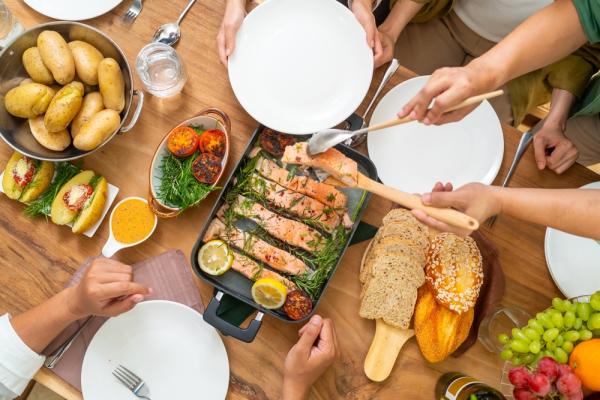July 10, 2013
Portion Size vs. Serving Size
Updated August 2024
Understanding the difference between portions and servings is a helpful step in planning meals for your family. Planning and preparing meals and snacks with servings and portions in mind can prevent food waste and help save money. Your family’s nutritional needs are unique. They are shaped by factors like health conditions and allergies, activity levels, age, and growth spurts.
First, let’s define these words:
A "serving" is a measured amount of a food or ingredient, such as a cup or an ounce of rice, used in providing dietary guidance (recommendations) or making comparisons among similar foods. Nutrition labels will tell you the serving size and the amount of nutrients each serving provides, such as 4 grams of fiber in 1 cup of cooked oatmeal.
A "portion" is how much food you choose to eat, whether at a restaurant, from a package, or prepared at home. It’s the amount you put on your plate and consume. A balanced meal might include multiple servings of some foods in one portion. For example, say you eat a meal of black bean tacos on tortillas, topped with salsa made from tomatoes, peppers, and corn. With this balanced meal, you’re well on your way to eating the five servings of vegetables a day recommended by the American Heart Association.
Servings and portions are not always the same. One key to helping kids stay healthy is eating portion sizes that meet their nutritional needs. Your family’s health care provider can help you identify nutritional needs and underlying health concerns. Communicate with a medical provider if you notice sudden changes in your child’s behaviors or have concerns about their growth and development.
What does “1 serving” mean?
Many common foods have standardized serving sizes. Consider these examples from My Plate (USDA):
- 1 slice of bread (so a sandwich has two servings of bread)
- 1/2 cup cooked rice or pasta
- 1 pancake (about the size of a CD)
- 1 small piece of fruit (about the size of your fist)
- 1 cup (8 fluid ounces) of 100% fruit juice (most small bottles of juice are 8-12 fluid ounces)
- 1 cup of milk or yogurt
- 1/2 cup of ice cream (about the size of a tennis ball)
- 1 1/2 ounces of cheese (about the size of a small matchbox)
- 2 to 3 ounces of meat, chicken, or fish (about the size of a deck of cards)
- 1/2 cup cooked beans or lentils (also about the size of a tennis ball)
Figuring out portions for your family
Being mindful of what and how much you eat during each meal and snack can help you identify how much of your favorite foods you need to feel satisfied, energized, and healthy. Try these mindful meal tips with the whole family:
Dish it out: It’s easy to eat several servings in one sitting if you eat directly out of a container. Put food into a dish one serving at a time and pay attention to how you feel after finishing it.
Start with a “me moment”: Stress raises levels of the hormone cortisol, which can make us feel hungry. It can also distract us from paying attention to how food makes us feel. Before meals, try taking a “me moment” to connect your mind and body.
Check in between portions: Start with one portion. Then, wait a few minutes and pay attention to whether you feel full, hungry, or thirsty. It can take time for your stomach to tell your brain that it’s full. Starting small can also help kids of all ages feel less overwhelmed when they try new foods.
Keep it simple: Prepare foods that have obvious portions, like slices of bread. You can also buy foods in individual portions (check the label) to take out some of the guesswork.
What about portions when you eat at a restaurant?
Here are some tips for eating mindfully away from home:
Stay mindful: Practice the same mindfulness tips you use at home to make sure you’re meeting your nutritional needs. Once you are satisfied, ask for a box to take home leftovers.
Share and care: Splitting dishes can help you save money and eat “at-home” portions while you’re out. This is also a good option if you won’t be able to store leftovers after the meal.
Ask for the “allergies” menu: Many eateries – especially chain restaurants – will have a menu that includes potential allergens, ingredients lists, and nutrition labels for each dish they serve. Check their website or ask a server for one of these menus, if you’re curious about what’s in each portion.
Enjoy the experience: Dining out isn’t just about the food you eat. You might take the family out to celebrate a milestone, meet up with friends and family, or treat yourself to a solo meal without cooking and cleaning up. Savor every part of your meal.


